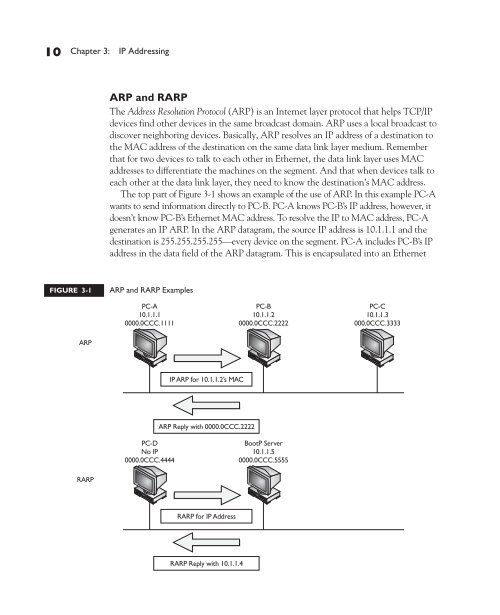ch03 IP Addressing.pdf - The Cisco Learning Network
ch03 IP Addressing.pdf - The Cisco Learning Network
ch03 IP Addressing.pdf - The Cisco Learning Network
You also want an ePaper? Increase the reach of your titles
YUMPU automatically turns print PDFs into web optimized ePapers that Google loves.
10 Chapter 3: <strong>IP</strong> <strong>Addressing</strong><br />
ARP and RARP<br />
<strong>The</strong> Address Resolution Protocol (ARP) is an Internet layer protocol that helps TCP/<strong>IP</strong><br />
devices find other devices in the same broadcast domain. ARP uses a local broadcast to<br />
discover neighboring devices. Basically, ARP resolves an <strong>IP</strong> address of a destination to<br />
the MAC address of the destination on the same data link layer medium. Remember<br />
that for two devices to talk to each other in Ethernet, the data link layer uses MAC<br />
addresses to differentiate the machines on the segment. And that when devices talk to<br />
each other at the data link layer, they need to know the destination’s MAC address.<br />
<strong>The</strong> top part of Figure 3-1 shows an example of the use of ARP. In this example PC-A<br />
wants to send information directly to PC-B. PC-A knows PC-B’s <strong>IP</strong> address, however, it<br />
doesn’t know PC-B’s Ethernet MAC address. To resolve the <strong>IP</strong> to MAC address, PC-A<br />
generates an <strong>IP</strong> ARP. In the ARP datagram, the source <strong>IP</strong> address is 10.1.1.1 and the<br />
destination is 255.255.255.255—every device on the segment. PC-A includes PC-B’s <strong>IP</strong><br />
address in the data field of the ARP datagram. This is encapsulated into an Ethernet<br />
FIGURE 3-1 ARP and RARP Examples

















